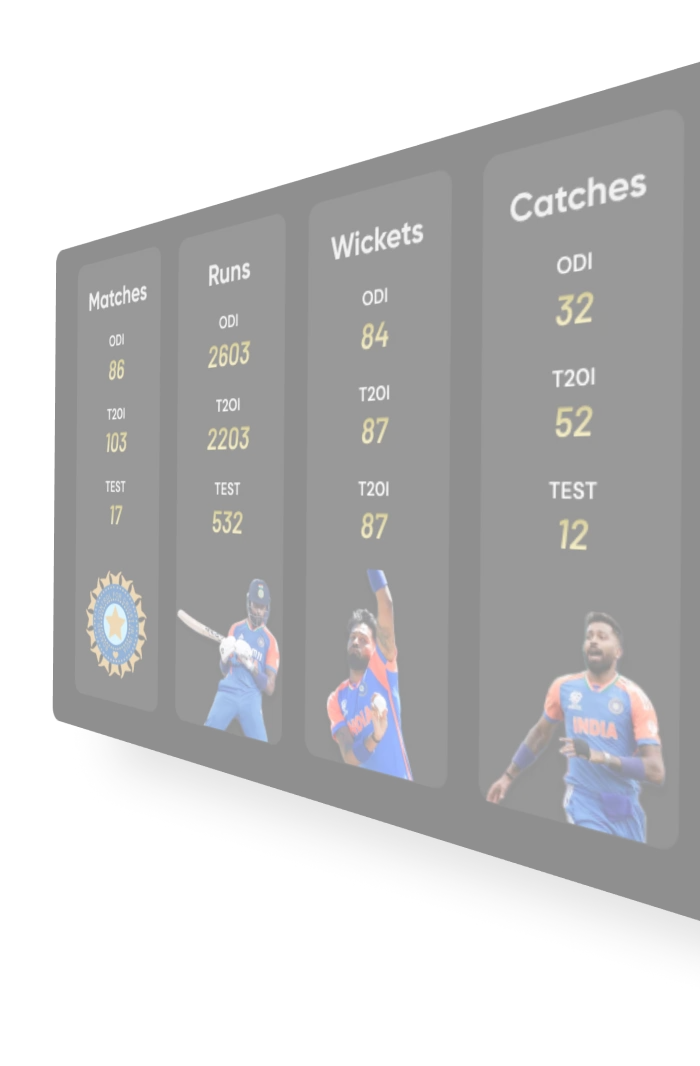
Table Of Contents
The first name on this list is the great Indian leg-spinner Anil Kumble, who was playing a Test against West Indies in Antigua. This match took place in the year 2002. During India's first innings, Kumble was batting and a fast ball bounced and hit his helmet. Kumble's jaw was broken and blood oozed out. After this, he came to the field with a bandage on his broken jaw and while bowling, he dismissed Brian Lara, this match was a draw.
There are many contenders for the Greatest of All Time (GOAT) in cricket history. Many people believe that Don Bradman is the real deserving of this title, some claim this about Sir Viv Richards, while many people consider Virat Kohli the real deserving of this title in modern cricket. However, if there is anything more honorable than GOAT, then it is that of 'God'.
Born on 24 April 1973, Sachin Ramesh Tendulkar changed the definition of Indian cricket. The batsman who has scored 100 centuries, the most runs in world test cricket at an average of 53.78 in 329 innings in 200 test matches and the most runs in 463 ODI matches is right to be called the 'God of Cricket'.
The world salutes fame and success, but the strong willpower required to earn both of these. Sachin Tendulkar always had it. It was on 15 November 1989. That year Sachin Tendulkar made his debut against Pakistan. At that time Sachin was just 16 years and 205 days old. This young batsman was facing the pair of Waqar Younis and Wasim Akram. The big batsmen of that time were no match for this pair of fast bowlers.
Sachin could not show anything special in his debut match. He was clean bowled by Waqar Younis after scoring just 15 runs. In the second match, young Tendulkar played an innings of 59 runs. After the third test match, the series was tied at 0-0.
In the last match of the series, i.e. the fourth match, Sachin did such a feat that the world salutes him even today. In the first innings of this match played in Sialkot, Pakistan, Team India took a lead of 65 runs. Whereas, in the second innings, the pair of Waqar Younis and Wasim Akram put the Indian batsmen to a tough test. In the second innings, Team India had lost four wickets for 38 runs. After this Sachin came to bat. Navjot Singh Sidhu was present at the crease to support Sachin.
Waqar Younis came to bowl against Sachin on the green top wicket. Waqar bowled a short ball in his over which Sachin was completely unable to play and the ball hit his nose. After being hit by the ball, his nose started bleeding and it broke. Team India's physio reached the field and bandaged his nose. His fellow batsman Navjot Singh Sidhu and physio advised him to retire hurt and go to the dressing room.
Pakistani cricketers also expected that a young boy would go out of the field after getting injured. But, Navjot Singh Sidhu and physio were stunned to hear what Sachin said after getting injured. Injured Sachin said in his Mumbai style, "I will play." These two words expressed that a new star has been born in Indian cricket, who will make the country the world champion in this game.
In 2021, when the Indian team was playing the Sydney Test on the Australia tour, Hanuma Vihari was suffering from a hamstring injury but continued to bat in the second innings. He faced a total of 161 balls and scored 23 runs. He also faced balls on his body but drew the match. Adding more to this everyone knew how crucial that test match was for India to keep going in the series so in that aspect his innings was quite something else. And eventually India defeated Australia in the 4th and final test to clinch the series 2-1, not forgetting Pant’s heroics.
Rishabh Pant, Old Trafford (2025)
Indian team's wicketkeeper batsman Rishabh Pant decided to play in the Manchester Test match against England in 2025 despite a broken toe. On the first day, he retired hurt after hitting his shoe and on the second day, when some batsmen were out, he came back to play and scored a fifty. He hit a six to a dreaded bowler like Archer. Pant supported the team despite the pain. This whole tour for India is full of injuries and at this stage showing this type of determination from the vice-captain of the Indian team is something else. Noteworthy is that according to several reports in the media he was asked to rest for 6 weeks by the medical team but probably he is made of something else.


Mohinder Amarnath, 1983 (Queen's Park Oval)
1983 World Cup-winning legend Mohinder Amarnath had a tough tour against the West Indies that year. During a Test match against them, Amarnath was hit on the face by a bouncer from Malcolm Marshall. He had retired hurt at that time, but was determined to make a comeback. He not only made a comeback, but batted for almost two more hours and scored a brilliant 80. He played crucial innings of 91 and 80 runs in the first and second innings. India's total score was 209 runs, and in the second innings, West Indies achieved a score of 277 runs without losing any wicket. India eventually lost the match by 10 wickets. But Amarnath was named Player of the Match for his stellar performance.
Murali Vijay, 2016-17 (Home season)
Every cricket fan would be aware of how hectic the schedule of Indian cricket is almost all the time. 2016-17 was no different. Teams like Sri Lanka, Australia and England toured India and Murali Vijay played almost the entire season with a fractured wrist. The pain was clearly visible throughout the season. Still, he scored 771 runs, the third-highest for India that season, which shows the vital role he played despite a serious injury.


VVS Laxman, Mohali (2010)
Who can forget the one-wicket win against the strong Australian team at Mohali. In this match, Laxman gave one of his best performances in the Test match played against Australia at Mohali in 2010. It was clearly visible how much he was struggling with his back spasm at that time, even walking was becoming difficult for him.
Despite this, he played a brilliant innings of 73 runs not out. His innings played an important role in India chasing the target of 216 runs and winning by one wicket. The most interesting thing in this Test was how Laxman batted with lower order players like Pragyan Ojha and Ishant Sharma. And winning against a team like Australia in that era was a matter of pride not only for VVS Laxman but for the entire Indian team.
Ravichandran Ashwin, Sydney (2021)
Facing Mitchell Starc, Pat Cummins and Josh Hazlewood together is a nightmare for any batsman. But Ashwin was in a completely different mood in the Sydney Test of the Border-Gavaskar series.
Ashwin, who was battling "batterings and bruises" during his attempt to save the match, was so restless that he did not sleep the previous night. Still, he batted for 128 balls and scored an unbeaten 39, and withstood the immense pressure of the Australian fast bowling attack. It also highlighted the collective spirit of the 2021 Indian team, which achieved one of the greatest Test series wins despite injuries.


Sunil Gavaskar, 1983 (Delhi)
Every batsman of the late 80s and 90s would say that he was most scared of facing West Indies bowlers. Some batsmen even used to say that whenever they came to bowl, it seemed as if the ball was coming from the clouds and not from their hands. One such incident happened during West Indies' tour of India in 1983 and the Delhi Test. Sunil displayed amazing courage in the 1983 Test match against West Indies. A fast ball from Malcolm Marshall hit his forearm and he suffered a deep injury so severe that it was difficult to even hold the bat. But we all know how much Indians love batting. Despite his injury, he continued to bat and scored 121 runs in India's first innings. Facing West Indies fast bowlers like Marshall, Michael Holding and Andy Roberts was a defining moment in his career.
Jasprit Bumrah, Sydney (2021)
Well, this story is also from the same match in which Ravichandran Ashwin and Hanuma Vihari were struggling with injuries. That Border-Gavaskar series was full of injuries for India. The number was so high that no one could have imagined.
And with this, players like Mohammed Siraj and Washington Sundar got a chance to debut in Test cricket for India. Talking about Bumrah, he suffered an abdominal strain during the third Test in Sydney, but he continued bowling and fielding, and many times asked the medical staff to stay on the field. This highlighted the physical burden of fast bowling in Test cricket and the sacrifices players make to keep their team in the match.
Talking about India's tour of Australia in 2021, the condition was such that the Indian team was termed as a "mini-hospital", with coach Ravi Shastri and captain Ajinkya Rahane struggling to field a fit playing XI. The 2021 Border-Gavaskar Trophy in Australia is an example of the injury challenges faced by Indian cricketers in Test cricket. The series saw an unprecedented number of players suffering from injuries, with the likes of Mohammed Shami (forearm fracture), Umesh Yadav (shin strain), KL Rahul (wrist), Ravindra Jadeja (thumb fracture) and Hanuma Vihari (hamstring strain) joining Bumrah in the injured list.


What are the main reasons behind injuries in Test cricket?
Test cricket can be very tiring at times for anyone, be it batsman or bowler. Fast bowlers have to deal with repeated pressure on their back, shoulders and knees, which can lead to injuries such as stress fractures, side strains and hamstring tears. Batsmen are susceptible to injuries caused by fast balls, such as fractures or bruises, while fielders are at risk of sprains and strains from diving or sudden movements. But what are some of the main reasons behind injuries in the first place?
Workload Management: With the busy cricket calendar especially for the Indian team and now with the various T20 cricket leagues around the world, any professional player is left with very little time to rest.
Physical pressure: Fast bowlers like Bumrah, who rely on a unique action, are more prone to injuries because of the pressure they put on their bodies.
Mental pressure: The expectation of doing well in important series for India can motivate players to continue playing despite injuries, as seen with Kumble, Pant and others.




More Links